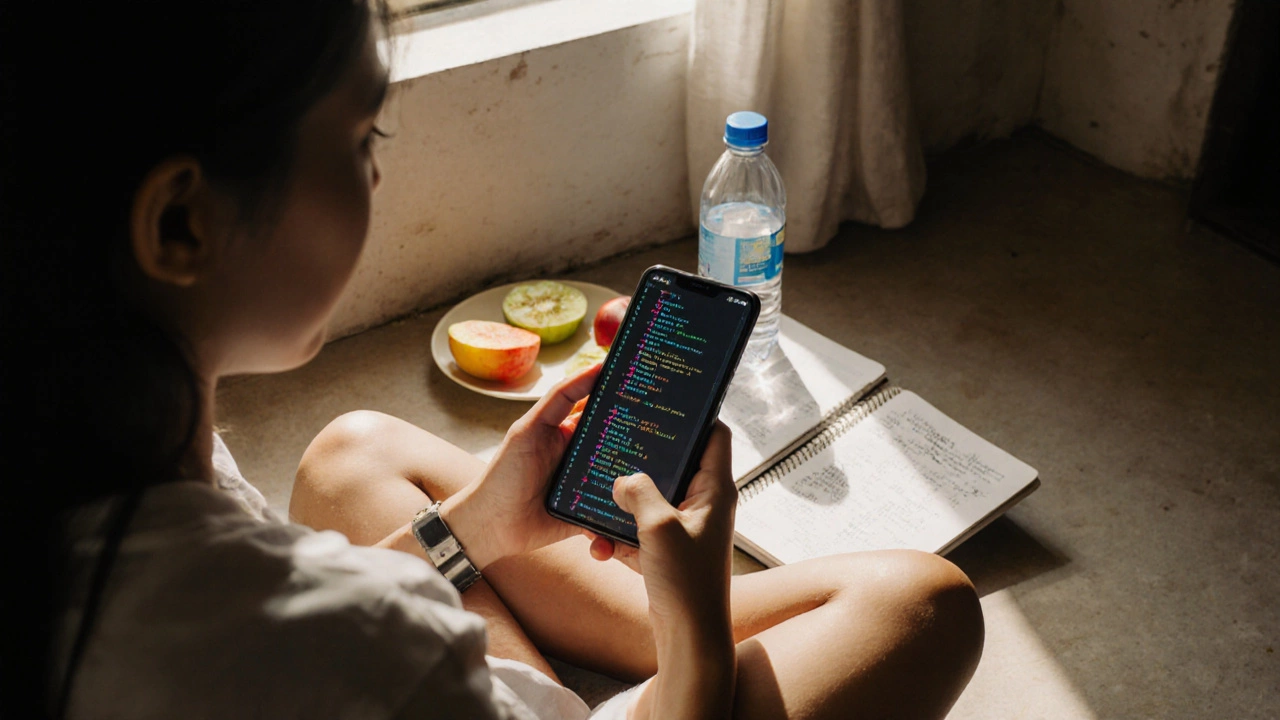Oct
29

- by Dhruv Ainsley
- 0 Comments
Phone Coding App Finder
Find the perfect coding app for your phone based on platform, language, and what you want to build.
Recommended Apps
Think coding needs a big keyboard, a powerful laptop, and a desk? Think again. Millions of people now write real code-full apps, websites, even games-right from their phones. No laptop. No fancy setup. Just a touchscreen and a good app. If you’ve ever wondered if you can code with a phone, the answer isn’t just yes-it’s code on phone better than you think.
It’s Not Just a Toy Anymore
Five years ago, coding on a phone felt like a gimmick. You’d open an app, type a few lines, and get a "Hello World" that crashed after two seconds. Today? Apps like Termux, Pydroid 3, and AIDE let you run Python, JavaScript, Java, and even C++ directly on Android. iOS users aren’t left behind either-CodeToGo, Swift Playgrounds, and GitHub Codespaces on Safari make it possible to write, test, and deploy code from an iPhone.Real people are using this. A student in Jakarta built a local food delivery app using only her Samsung Galaxy A52. A single mom in Nairobi coded a WhatsApp-based reminder system for her small tailoring shop using Python and Termux. A teenager in Melbourne coded a simple habit tracker app in Swift on his iPad during bus rides to school. These aren’t demo projects. These are working tools people use every day.
What Can You Actually Build?
You won’t be compiling a full-scale enterprise app like Instagram on your phone-but you can build plenty that matters:- Simple Android or iOS apps with drag-and-drop tools like Thunkable or Appy Pie
- Web apps using HTML, CSS, and JavaScript in apps like KodeLife or WebMaster
- Automated scripts for file organization, data scraping, or social media posting with Python
- Basic games with Unity or Godot via cloud editors
- Command-line tools for data analysis or automation using Termux on Android
One user on Reddit built a script that auto-schedules Instagram posts using Python on his phone. He runs it every morning before work. Another built a weather alert system for his garden using a Raspberry Pi and a phone-based Python script that checks sensor data via SSH. These aren’t theoretical-they’re daily workflows.
How to Get Started (No Experience Needed)
You don’t need to be a tech expert. Here’s how to start coding on your phone today:- Choose your language: Start with Python if you’re new. It’s readable, forgiving, and widely supported on mobile.
- Download the right app: On Android, install Termux (free, open-source). On iOS, try Pydroid 3 or Swift Playgrounds.
- Follow a mobile-friendly course: Use free platforms like Sololearn, Grasshopper, or Programming Hub. They’re built for small screens and touch input.
- Code something tiny: Write a calculator, a to-do list, or a number-guessing game. Complete it. Then do it again.
- Connect to GitHub: Use the GitHub app to push your code. You’ll start thinking like a real developer.
One rule: don’t wait for perfect conditions. If you’re waiting for a laptop, you’ll never start. But if you open your phone right now and launch Termux, you can type python3 and hit enter-and you’re coding.

Limitations? Yes. Dealbreakers? No.
Let’s be honest: phones aren’t perfect for coding. You can’t easily run 10+ tabs of code side by side. Debugging complex errors is harder on a small screen. Copy-pasting between files gets annoying. And if you’re building a large app with dozens of files, a keyboard and monitor will always be faster.But here’s what most people miss: you don’t need perfection to learn. You need consistency. If you code for 15 minutes every morning on your phone, you’ll build more skill in a month than someone who waits for a "perfect setup" and never starts.
Many developers use phones for quick edits, testing, or learning. Even professionals keep a phone handy to fix a bug while waiting in line or during a commute. It’s not about replacing your laptop-it’s about removing the excuse to not code.
Best Apps for Coding on Phone in 2025
Not all apps are equal. Here’s what actually works:
| App Name | Platform | Best For | Key Feature |
|---|---|---|---|
| Termux | Android | Python, Bash, C++, Node.js | Full Linux terminal on phone |
| Pydroid 3 | Android | Python beginners | Pre-installed libraries, no setup needed |
| Swift Playgrounds | iOS | Learning Swift, iOS apps | Interactive lessons from Apple |
| Grasshopper | iOS, Android | JavaScript basics | Game-like lessons, no typing required at first |
| CodeToGo | iOS | HTML/CSS/JS web dev | Live preview as you type |
| GitHub Codespaces (via browser) | iOS, Android | Full IDE in browser | Uses cloud computer-your phone is just a screen |
For absolute beginners: start with Grasshopper or Swift Playgrounds. They’re designed to teach without overwhelm. For those ready to go deeper: Termux + Python is the most powerful combo on Android.
Real Stories: People Who Code on Phones
A 68-year-old retired teacher in Melbourne learned Python on her iPad to automate her garden watering schedule. She now shares her scripts with neighbors. A college student in Bangalore coded a bus tracker app using only his Xiaomi phone and free APIs. It’s used by 300 students daily. A single father in Lagos built a SMS-based loan reminder system for his small business using Python and Termux. He didn’t have a computer-he had a phone and 20 minutes a day.
These aren’t outliers. They’re proof that access, not equipment, is the real barrier to learning code. If you have a phone, you have the tool.
Why This Matters for the Future
By 2030, over 60% of the world’s population will have smartphones-but only 30% will have access to a reliable computer. Mobile coding isn’t a niche trend. It’s the next wave of digital inclusion. Countries like India, Nigeria, and Indonesia are already using mobile coding platforms to teach programming in rural schools. Google and Microsoft are investing in mobile-first coding tools because they know the future isn’t desktop-bound.
Learning to code on a phone isn’t about compromise. It’s about empowerment. It means you don’t need to wait for a scholarship, a computer, or a job to start building. You can start today-with what you already have.
Can I really build an app with just my phone?
Yes, you can build and publish simple apps using tools like Thunkable, Appy Pie, or Swift Playgrounds. These let you design interfaces visually and add logic without writing complex code. For more control, you can write full apps in Python or JavaScript using Termux or CodeToGo. You won’t build a TikTok clone on your phone-but you can build a working tool that solves a real problem, and that’s where real learning begins.
Is coding on a phone slower than on a laptop?
Yes, it’s slower for complex tasks. Typing on a touchscreen isn’t as fast as a mechanical keyboard. Switching between files is clunkier. But for learning, debugging small errors, or making quick edits? It’s often faster. You don’t need to wait to get home or find a computer. You can code while waiting for coffee, on the bus, or during a lunch break. Speed isn’t everything-consistency is.
Do I need to buy a keyboard for my phone to code?
Not at all. You can code just fine with the on-screen keyboard. But if you plan to write more than 100 lines a day, a Bluetooth keyboard under $30 makes a huge difference. It’s not required, but it turns coding on your phone from a chore into a smooth workflow. Many people start without one, then get one after a few weeks.
Can I use GitHub on my phone?
Yes. The official GitHub app lets you view repositories, commit changes, and even edit files directly on your phone. You can also use Termux or CodeToGo to push code via Git commands. Many developers use their phones to push small fixes or updates while on the go. It’s not ideal for huge merges-but it’s perfectly fine for daily use.
Will learning on a phone prepare me for a coding job?
Absolutely. Many bootcamps and employers care more about what you’ve built than what device you used to build it. If you’ve shipped a working app, automated a task, or solved real problems with code-your phone didn’t hold you back. In fact, being able to code anywhere shows initiative, adaptability, and problem-solving skills-all highly valued in tech jobs.
What’s Next?
Start small. Open your phone right now. Download Termux (Android) or Pydroid 3 (iOS). Type print("Hello, world"). Run it. That’s it. You just coded.
Don’t wait for the perfect time. Don’t wait for the perfect device. The most powerful tool you need is already in your pocket. All you have to do is start typing.





